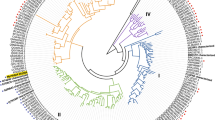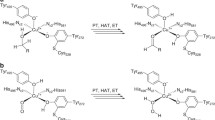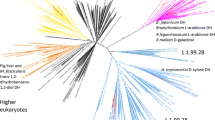Abstract
We describe here the characterization of a novel enzyme called aldose-aldose oxidoreductase (Cc AAOR; EC 1.1.99) from Caulobacter crescentus. The Cc AAOR exists in solution as a dimer, belongs to the Gfo/Idh/MocA family and shows homology with the glucose-fructose oxidoreductase from Zymomonas mobilis. However, unlike other known members of this protein family, Cc AAOR is specific for aldose sugars and can be in the same catalytic cycle both oxidise and reduce a panel of monosaccharides at the C1 position, producing in each case the corresponding aldonolactone and alditol, respectively. Cc AAOR contains a tightly-bound nicotinamide cofactor, which is regenerated in this oxidation-reduction cycle. The highest oxidation activity was detected on d-glucose but significant activity was also observed on d-xylose, l-arabinose and d-galactose, revealing that both hexose and pentose sugars are accepted as substrates by Cc AAOR. The configuration at the C2 and C3 positions of the saccharides was shown to be especially important for the substrate binding. Interestingly, besides monosaccharides, Cc AAOR can also oxidise a range of 1,4-linked oligosaccharides having aldose unit at the reducing end, such as lactose, malto- and cello-oligosaccharides as well as xylotetraose. 1H NMR used to monitor the oxidation and reduction reaction simultaneously, demonstrated that although d-glucose has the highest affinity and is also oxidised most efficiently by Cc AAOR, the reduction of d-glucose is clearly not as efficient. For the overall reaction catalysed by Cc AAOR, the l-arabinose, d-xylose and d-galactose were the most potent substrates.







Similar content being viewed by others
References
Arnold K, Bordoli L, Kopp J, Schwede T (2006) The SWISS-MODEL workspace: a web-based environment for protein structure homology modelling. Bioinformatics 22:195–201. doi:10.1093/bioinformatics/bti770
Aro-Kärkkäinen N, Toivari M, Maaheimo H, Ylilauri M, Pentikäinen OT, Andberg M, Oja M, Penttilä M, Wiebe MG, Ruohonen L, Koivula A (2014) L-arabinose/D-galactose 1-dehydrogenase of Rhizobium leguminosarum bv. trifolii characterised and applied for bioconversion of L-arabinose to L-arabonate with Saccharomyces cerevisiae. Appl Microbiol Biotechnol 98:9653–9665. doi:10.1007/s00253-014-6039-2
Benkert P, Biasini M, Schwede T (2011) Toward the estimation of the absolute quality of individual protein structure models. Bioinformatics 27:343–350. doi:10.1093/bioinformatics/btq662
Benkert P, Künzli M, Schwede T (2009) QMEAN server for protein model quality estimation. Nucleic Acids Res 37:W510–W514. doi:10.1093/nar/gkp322
Benkert P, Tosatto SCE, Schomburg D (2008) QMEAN: a comprehensive scoring function for model quality assessment. Proteins 71:261–277. doi:10.1002/prot.21715
Berghäll S, Hilditch S, Penttilä M, Richard P (2007) Identification in the mould Hypocrea jecorina of a gene encoding an NADP(+): D-xylose dehydrogenase. FEMS Microbiol Lett 277:249–253. doi:10.1111/j.1574-6968.2007.00969.x
Boer H, Maaheimo H, Koivula A, Penttilä M, Richard P (2010) Identification in Agrobacterium tumefaciens of the D-galacturonic acid dehydrogenase gene. Appl Microbiol Biotechnol 86:901–909. doi:10.1007/s00253-009-2333-9
Dambe TR, Kühn AM, Brossette T, Giffhorn F, Scheidig AJ (2006) Crystal structure of NADP(H)-dependent 1,5-anhydro- D -fructose reductase from Sinorhizobium morelense at 2.2 Å resolution: Construction of a NADH-accepting mutant and its application in rare sugar synthesis. Biochemistry 45:10030–10042. doi:10.1021/bi052589q
Dumon C, Song L, Bozonnet S, Fauré R, O’Donohue MJ (2012) Progress and future prospects for pentose-specific biocatalysts in biorefining. Process Biochem 47:346–357. doi:10.1016/j.procbio.2011.06.017
Fürlinger M, Satory M, Haltrich D, Kulbe KD, Nidetzky B (1998) Control of the association state of tetrameric glucose-fructose oxidoreductase from Zymomonas mobilis as the rationale for stabilization of the enzyme in biochemical reactors. J Biochem 124:280–286
Guex N, Peitsch MC (1997) SWISS-MODEL and the Swiss-PdbViewer: an environment for comparative protein modeling. Electrophoresis 18:2714–2723. doi:10.1002/elps.1150181505
Halaka F, Babcock G, Dye J (1982) Properties of 5-methylphenazinium methyl sulfate Reaction of the oxidized form with NADH and of the reduced form with oxygen. J Biol Chem 257:1458–1461
Hanukoglu I, Gutfinger T (1989) cDNA sequence of adrenodoxin reductase. Identification of NADP-binding sites in oxidoreductases. Eur J Biochem 180:479–484. doi:10.1111/j.1432-1033.1989.tb14671.x
Hardman MJ, Scopes RK (1988) The kinetics of glucose-fructose oxidoreductase from Zymomonas mobilis. Eur J Biochem 173:203–209
Heuts DPHM, Janssen DB, Fraaije MW (2007) Changing the substrate specificity of a chitooligosaccharide oxidase from Fusarium graminearum by model-inspired site-directed mutagenesis. FEBS Lett 581:4905–4909. doi:10.1016/j.febslet.2007.09.019
Jermyn MA (1960) Studied on the glucono-D-lactonase of Pseudomonas fluorescens. Biochim Biophys Acta 37:78–92
Jia G, Qiu S, Li G, Zhou J, Feng Z, Li C (2009) Alkali-hydrolysis of D-glucono-delta-lactone studied by chiral raman and circular dichroism spectroscopies. Sci China Ser B Chem 52:552–558. doi:10.1007/s11426-009-0085-0
Johnsen U, Schönheit P (2004) Novel xylose dehydrogenase in the halophilic archaeon Haloarcula marismortui. J Bacteriol 186:6198–6207. doi:10.1128/JB.186.18.6198-6207.2004
Kanagasundaram V, Scopes RK (1992) Cloning, sequence analysis, and expression of the structural gene encoding glucose-fructose oxidoreductase from Zymomonas mobilis. J Bacteriol 174:1439–1447
Kiefer F, Arnold K, Künzli M, Bordoli L, Schwede T (2009) The SWISS-MODEL repository and associated resources. Nucleic Acids Res 37:D387–D392. doi:10.1093/nar/gkn750
Kingston RL, Scopes RK, Baker EN (1996) The structure of glucose-fructose oxidoreductase from Zymomonas mobilis: an osmoprotective periplasmic enzyme containing non-dissociable NADP. Structure 4:1413–1428. doi:10.1016/S0969-2126(96)00149-9
Kiryu T, Nakano H, Kiso T, Murakami H (2008) Purification and characterization of a carbohydrate: acceptor oxidoreductase from Paraconiothyrium sp. that produces lactobionic acid efficiently. Biosci Biotechnol Biochem 72:833–841. doi:10.1271/bbb.70701
Lee M-H, Lai W-L, Lin S-F, Liu Y, Hsu Y-H, Tsai Y-C (2006) Purification and characterization of a novel cellooligosaccharide oxidase from rice pathogen Sarocladium oryzae. Enzyme Microbiol Technol 39:85–91. doi:10.1016/j.enzmictec.2005.09.011
Lien OG (1959) Determination of gluconolactone, galactonolactone, and their free acids by hydroxamate method. Anal Chem 31:1363–1366. doi:10.1021/ac60152a035
Lin S-F, Yang T-Y, Inukai T, Yamasaki M, Tsai Y-C (1991) Purification and characterization of a novel glucooligosaccharide oxidase from Acremonium strictum T1. Biochim Biophys Acta Protein Struct Mol Enzymol 1118:41–47. doi:10.1016/0167-4838(91)90439-7
Lott JSS, Halbig D, Baker HM, Hardman MJ, Sprenger GA, Baker EN (2000) Crystal structure of a truncated mutant of glucose-fructose oxidoreductase shows that an N-terminal arm controls tetramer formation. J Mol Biol 304:575–584. doi:10.1006/jmbi.2000.4245
Malvessi E, Carra S, Pasquali FC, Kern DB, da Silveira MM, Ayub MAZ (2013) Production of organic acids by periplasmic enzymes present in free and immobilized cells of Zymomonas mobilis. J Ind Microbiol Biotechnol 40:1–10. doi:10.1007/s10295-012-1198-6
Neuhaus D, Ismail IM, Chung C-W (1996) “FLIPSY”—a new solvent-suppression sequence for nonexchanging solutes offering improved integral accuracy relative to 1D NOESY. J Magn Reson Ser A 118:256–263. doi:10.1006/jmra.1996.0034
Nurizzo D, Halbig D, Sprenger GA, Baker EN (2001) Crystal structures of the precursor form of glucose-fructose oxidoreductase from Zymomonas mobilis and its complexes with bound ligands. Biochemistry 40:13857–13867. doi:10.1021/bi011355d
Peitsch MC (1995) Protein modeling by E-mail. Bio/Technology 13:658–660. doi:10.1038/nbt0795-658
Peng F, Peng P, Xu F, Sun R-C (2012) Fractional purification and bioconversion of hemicelluloses. Biotechnol Adv 30:879–903. doi:10.1016/j.biotechadv.2012.01.018
Pocker Y, Green E (1973) Hydrolysis of D-glucono-δ-lactone. I. General acid-base catalysis, solvent deuterium isotope effects, and transition state characterization. J Am Chem Soc 95:113–119. doi:10.1021/ja00782a019
Potterton L, McNicholas S, Krissinel E, Gruber J, Cowtan K, Emsley P, Murshudov GN, Cohen S, Perrakis A, Noble M (2004) Developments in the CCP4 molecular-graphics project. Acta Crystallogr D Biol Crystallogr 60:2288–2294. doi:10.1107/S0907444904023716
Rokosh D, Kurz W, LaRue T (1973) A modification of isocitrate and malate dehydrogenase assays for use in crude cell free extracts. Anal Biochem 54:477–483
Rosenfeld J, Capdevielle J, Guillemot JC, Ferrara P (1992) In-gel digestion of proteins for internal sequence analysis after one- or two-dimensional gel electrophoresis. Anal Biochem 203:173–179. doi:10.1016/0003-2697(92)90061-B
Theander O (1980) Acids and other oxidation products. In: pigman W, horton D (Eds) the carbohydrates. Chemistry and biochemistry 2nd edn. Academic Press, New York, pp. 1013–1099
Toivari M, Nygård Y, Kumpula E-PP, Vehkomäki M-LL, Benčina M, Valkonen M, Maaheimo H, Andberg M, Koivula A, Ruohonen L, Penttilä M, Wiebe MG (2012) Metabolic engineering of Saccharomyces cerevisiae for bioconversion of D-xylose to D-xylonate. Metab Eng 14:427–436. doi:10.1016/j.ymben.2012.03.002
Whittaker JW (2005) The radical chemistry of galactose oxidase. Arch Biochem Biophys 433:227–239. doi:10.1016/j.abb.2004.08.034
Wiebe MG, Nygård Y, Oja M, Andberg M, Ruohonen L, Koivula A, Penttilä M, Toivari M (2015) A novel aldose-aldose oxidoreductase for co-production of D-xylonate and xylitol from D-xylose with Saccharomyces cerevisiae. Appl Microbiol Biotechnol. doi:10.1007/s00253-015-6878-5
Wiegert T, Sahm H, Sprenger GA (1997) The substitution of a single amino acid residue (Ser-116 -> Asp) alters NADP-containing glucose-fructose oxidoreductase of Zymomonas mobilis into a glucose dehydrogenase with dual coenzyme specificity. J Biol Chem 272:13126–13133. doi:10.1074/jbc.272.20.13126
Xu F, Golightly EJ, Fuglsang CC, Schneider P, Duke KR, Lam L, Christensen S, Brown KM, Jørgensen CT, Brown SH (2001) A novel carbohydrate:acceptor oxidoreductase from Microdochium nivale. Eur J Biochem 268:1136–1142. doi:10.1046/j.1432-1327.2001.01982.x
Zachariou M, Scopes RK (1986) Glucose-fructose oxidoreductase, a new enzyme isolated from Zymomonas mobilis that is responsible for sorbitol production. J Bacteriol 167:863–869
Zheng H, Bertwistle D, Sanders DAR, Palmer DRJ (2013) Converting NAD-specific inositol dehydrogenase to an efficient NADP-selective catalyst, with a surprising twist. Biochemistry 52:5876–5883. doi:10.1021/bi400821s
Acknowledgments
This study was financially supported by the Academy of Finland through the Centre of Excellence in White Biotechnology–Green Chemistry (decision number 118573). We thank Outi Liehunen and Jonas Excell for excellent technical assistance. Tobias Greuter (Bruker, Fällanded, Switzerland) is acknowledged for providing the modified firmware for the NMR sample changer.
Author information
Authors and Affiliations
Corresponding author
Ethics declarations
Conflict of interest
The authors declare that they have no competing interests.
Ethical statement
This article does not contain any studies with human participants or animals performed by any of the authors.
Electronic Supplementary Material
ESM 1
(PDF 335 kb)
Rights and permissions
About this article
Cite this article
Andberg, M., Maaheimo, H., Kumpula, EP. et al. Characterization of a unique Caulobacter crescentus aldose-aldose oxidoreductase having dual activities. Appl Microbiol Biotechnol 100, 673–685 (2016). https://doi.org/10.1007/s00253-015-7011-5
Received:
Revised:
Accepted:
Published:
Issue Date:
DOI: https://doi.org/10.1007/s00253-015-7011-5




